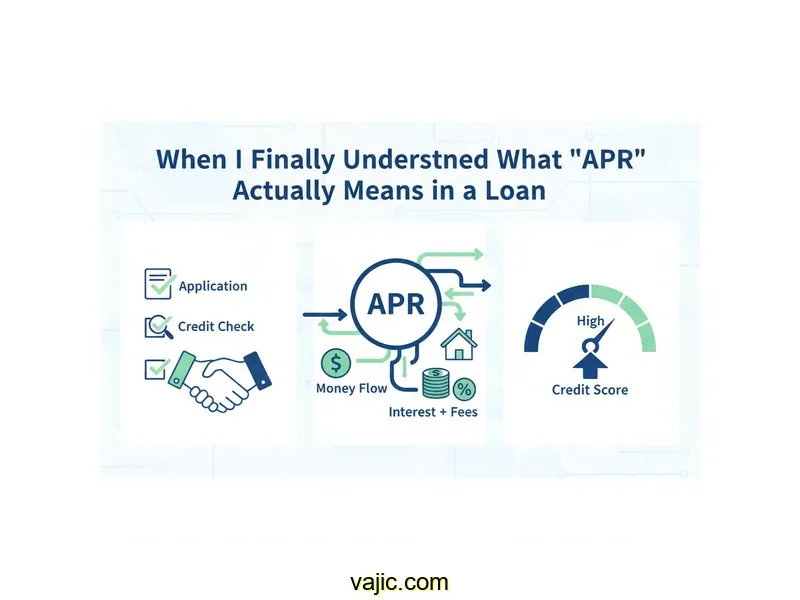
Auto Loan Calculator
Calculate payments over the life of your Loan
Home Blog Privacy Terms About Contact
Calculate payments over the life of your Loan
Home Blog Privacy Terms About ContactPublished on October 14, 2025

My journey into the world of loan calculations didn’t start with a grand plan to become a financial whiz. It began with a simple document and two numbers that just didn't seem to get along. I was looking at a sample loan illustration, just for educational purposes, and saw one line that read "Interest Rate: 6.8%" and another just below it that said "APR: 7.25%."
My immediate reaction was confusion. Weren't they the same thing? How could a loan have two different rates? It felt like a typo, or maybe some kind of confusing financial jargon designed to trip people up. My curiosity took over. I wasn't trying to make a financial decision; I just wanted to understand the math. What was this mysterious 0.45% difference, and where did it come from?
I decided to fire up a few online loan calculators to solve the mystery myself. I typed in the numbers from the illustration: a loan amount of $13,450 and a term of 48 months. Then, I confidently entered 6.8% into the "Interest Rate" field. The calculator spit out a monthly payment. But when I compared it to the monthly payment on the illustration, it was off. Not by a lot, but by a few dollars. And that was enough to tell me I was missing a key piece of the puzzle.
This little discrepancy was the start of it all. It became a personal mission to figure out what was happening behind the curtain of these online tools. This is my story of that discovery—a journey into understanding how calculations work, not a guide on what financial choices to make. It’s about empowering myself with calculation literacy, one number at a time.
My first attempts to solve the puzzle were a bit chaotic. I plugged the same numbers into three different basic loan calculators. I used a principal amount of $13,450, an interest rate of 6.8%, and a loan term of 48 months. Each calculator gave me the same monthly payment: roughly $318.57.
But the sample loan document I was studying showed a monthly payment of $321.99. It was a difference of only $3.42 per month, but over 48 months, that added up to over $164. To me, that wasn't a rounding error; it was a fundamental misunderstanding on my part. I was completely stumped. Why was my calculation consistently different from the official-looking one?
My mind raced through the possibilities. Was the calculator using a different formula? Did "48 months" mean something other than four years? I even tried entering the APR of 7.25% into the interest rate field. That gave me a monthly payment of $321.84—incredibly close, but still not an exact match. This only deepened my confusion. If APR was the "real" rate, why didn't it produce the exact payment number?
I started digging into the fine print of the sample loan document. Tucked away in a small box was a line item I had completely ignored: "Origination Fee: $269." I had seen it, but I thought it was just a separate charge, maybe something paid upfront. I never imagined it could be intertwined with the monthly payment calculation itself. I had assumed the loan calculators were all-knowing, but I was feeding them incomplete information. The problem wasn't the calculator; it was my understanding of the inputs.
This was the moment I realized that the "Interest Rate" and the "Total Cost of Borrowing" were two very different things. The 6.8% was the cost of the money, but that $269 fee was also part of the cost. The question was, how did that fee get baked into a percentage like 7.25% APR? That was the mystery I needed to solve next.
My frustration led me to search for something different. Instead of "simple loan calculator," I tried searching for an "advanced loan calculator" or "loan calculator with fees." That's when I found it: a calculator that had the familiar fields for loan amount, interest rate, and term, but also had an extra box labeled "Upfront Fees" or "Origination Fee."
This was my lightbulb moment. I went back to my original scenario. I entered the $13,450 loan amount, the 48-month term, and the 6.8% interest rate. Then, I cautiously typed $269 into the new "Fees" box. I hit "Calculate," and there it was. The calculator didn't just show me the monthly payment; it showed me the APR. And that APR was exactly 7.25%.
Suddenly, it all clicked. The APR wasn't a separate, mysterious interest rate. It was a calculated result that represented the total cost of borrowing—the interest rate plus the fees—expressed as a single, annualized percentage. The fee wasn't just a separate line item; it was mathematically woven into the fabric of the loan's cost. This discovery felt like finding a secret key that unlocked a new level of understanding.
My deep dive showed me that APR isn't arbitrary. It's calculated using a complex formula, but the concept is simple: it finds the interest rate that would make the loan payments equal the actual amount of money received, after fees. In my example, I was making payments on a $13,450 loan, but if the $269 fee was deducted, I only "received" $13,181. The 7.25% APR is the rate that mathematically connects those numbers over 48 months.
The most important thing I learned is that APR is designed to provide an apples-to-apples comparison. Imagine two loan offers. Loan A has a 6.5% interest rate with a $500 fee. Loan B has a 7.0% interest rate with no fee. Which is the better deal? Just by looking at the rates, it's hard to tell. But by calculating the APR for both, I could see the true, all-in cost of each loan side-by-side. The APR standardizes the comparison.
To make sure I really understood, I created a new hypothetical scenario: a $17,200 loan for 60 months at a 7.1% interest rate, with a 3% origination fee. First, I calculated the fee: 3% of $17,200 is $516. I then plugged all four numbers into my new favorite advanced calculator. It showed me the monthly payment and then calculated the APR: 8.34%. I ran this test a few more times with different numbers, and each time, I felt more confident. I had finally demystified the relationship between interest rate, fees, and APR.

This whole experience was incredibly empowering. It wasn't about finding the "best" loan, but about understanding the language of loans. Breaking down the math gave me a new perspective on how financial products are structured. Here are the biggest lessons I learned about the calculations themselves:
During my journey, a few questions kept popping up. Here are the answers I found, focused strictly on how the math works.
Think of it this way: the interest rate is used to calculate the interest charge on your outstanding balance each month. The APR is a broader calculation that starts with the interest rate and then factors in upfront lender fees to give you a more complete picture of the loan's total cost over a year.
You can get a very close estimate using an advanced online loan calculator. You'll need four key pieces of information from the quote: the total loan amount, the interest rate, the loan term (in months), and the exact dollar amount of all upfront fees (like origination or processing fees). Plugging these in should yield an APR very close to what's on the quote.
The most common reason is that basic calculators don't have a field for fees, so they can't calculate APR at all—they only calculate payments based on the interest rate. Even among advanced calculators, slight differences can occur based on how they handle things like the exact number of days in a year or rounding, but they should be very close if all inputs are the same.
Yes, in this specific scenario, they should be identical. Since the APR's job is to factor in the cost of fees, the absence of any fees means the only cost of borrowing is the interest itself. Therefore, the APR calculation would equal the interest rate.
My quest started with a simple question about two percentages on a piece of paper. It ended with a much deeper appreciation for the mechanics behind loan calculations. The biggest lesson for me wasn't about saving money or making a specific choice; it was about the confidence that comes from understanding.
I learned that APR isn't a trick; it's a tool for transparency. It's a standardized way to look at the total cost of borrowing, and once I understood how fees played into its calculation, the numbers finally made sense. It showed me that getting curious about financial math doesn't have to be intimidating. By playing with calculators and asking "why," I was able to turn a point of confusion into a moment of genuine clarity.
I hope my journey encourages you to ask your own questions and to see financial calculators not as magic boxes, but as powerful tools for learning. The more we understand how the numbers work, the more empowered we become.
This article is about understanding calculations and using tools. For financial decisions, always consult a qualified financial professional.
Disclaimer: This article documents my personal journey learning about loan calculations and how to use financial calculators. This is educational content about understanding math and using tools—not financial advice. Actual loan terms, rates, and costs vary based on individual circumstances, creditworthiness, and lender policies. Calculator results are estimates for educational purposes. Always verify calculations with your lender and consult a qualified financial advisor before making any financial decisions.
